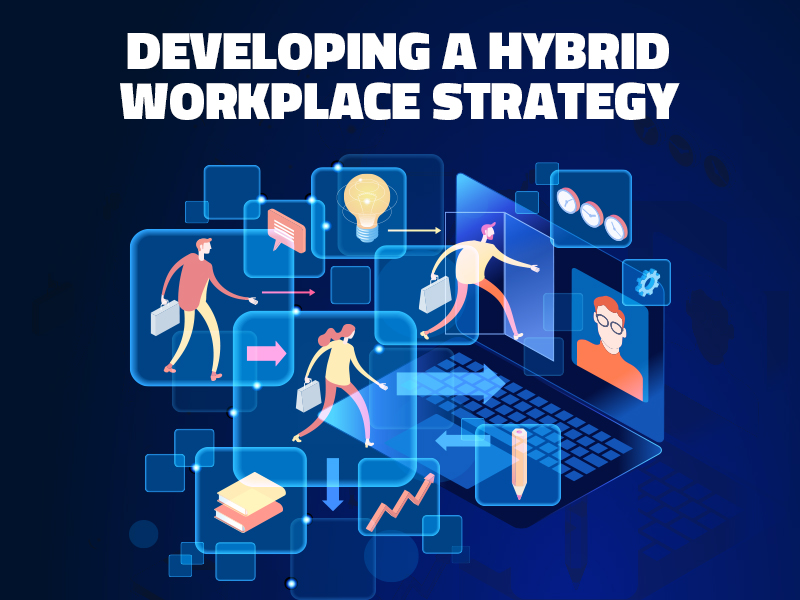It is no secret that the present epidemic and sociological shifts are causing changes in how we work and utilize the workplace in the future. Nevertheless, many firms are still attempting to determine what this entails and what changes they will need to deliver a hybrid workplace with improved employee freedom that will boost human performance while optimizing tactics.
Tips on developing a hybrid workplace strategy
- Providing Gen-Z experiences in all environments:
Future success will require a combination of adaptation and face-to-face and virtual teamwork. Employees must be supported throughout the day by various technologies for the hybrid workplace to transform your organization successfully. This necessitates intuitive software and intelligent devices that facilitate excellent collaboration and give insights to enhance user experiences continuously and enable you to install and maintain your solution on a safe and dependable platform.
Intelligent workplace solutions built for hybrid work can reduce the frequent difficulties associated with meetings, optimize spaces with agility, and create more productive surroundings. These surroundings ensure that every team member, whether in the office or working remotely, enjoys a first-rate experience.
The ideal plan involves establishing the new purpose of the office and the technology that will be used to support it; analyzing and resolving any challenges that may arise from working remotely; and investing in the most effective collaboration platform for the modern workplace.
- Determine which components of employees’ occupations are essential:
The concept of a hybrid workplace has existed for a considerable time. Before the pandemic, global corporations including Yahoo!, IBM, Reddit, Bank of America, Aetna, and AT&T had experimented with and essentially abandoned the idea of establishing hybrid work programs. This is due to a lack of communication amongst staff members, leading to lower motivation and performance.
After the initial thrill of being away from the office for a few months wore off, many individuals reported experiencing Zoom Meetings fatigue and the discomfort of sitting in an inappropriate position from an ergonomic perspective. Despite this, some individuals believe they have been afforded a greater opportunity to share their concerns, as Zoom Meetings is frequently linked with better meeting etiquette.
Some desire team-oriented spaces and lounge areas in the office. However, many safety-conscious employees are concerned about the ease of virus transmission in an open workplace design. Thus, open workplace layouts are becoming less common. If you want to see advances in job satisfaction and productivity, it is essential to cater to the many personality types that exist within your team. Encourage continuous feedback to guarantee that all voices are heard.
- Working remotely does not imply that you can accomplish work:
Effective hybrid work cultures clarify when employees are expected to be working versus when they are not likely to be working. On the employee side, remote workers are responsible for communicating their availability for meetings and requests. Regularly turning off their laptops and phones and separating themselves from their work should not make employees feel uneasy, as it is advantageous to the organization. According to research, remote workers often work longer hours than in-office employees. The risk of burnout is greater for remote workers if companies do not encourage them to set boundaries and take breaks.
Employees are not always free to work from any location of their choice when working remotely. Financial, legal, and operational issues may prompt a business to restrict employees’ residences to specific states, countries, or time zones. Individuals must be aware of these limitations so they cannot find employment by accident. This requires an explanation of the rationale for the various constraints.
- Integrate the online and offline experiences:
It can get difficult to bridge the gap between in-person and virtual participants. Moreover, hybrid work implies that there will always be at least one remote worker, regardless of how well teams organize their in-office days. Physically separated coworkers can experience irritation and a weakened sense of participation. This is especially true for tasks that demand creativity and innovation, such as brainstorming, which usually entails using analog whiteboards or other physical objects that are difficult for remote participants to experience fully.
The strategy combines physical surroundings and technology while keeping three fundamental concepts in mind: equity, engagement, and usability.
People must have clear views of each other and the subject matter being addressed to be completely engaged. Consider the lighting, the camera, the sound, and the content when planning for employee engagement in a digital-to-physical context. We have discovered that slanted or moveable tables, increased illumination, additional speakers, in-room microphones, and easily movable marker boards and displays can be excellent solutions to this issue.
- In-person meetings are an integral part of hybrid work:
Effective hybrid office cultures necessitate regular face-to-face encounters. A vital component of a mixed strategy is determining when and for what purpose people are expected to assemble. In addition to spending money on renting meeting spaces and supporting travel expenses so in-person meetings can occur, additional funds must be allocated for meeting-related expenses.
Employers should not expect employees to be in the same area at the same time unless there is an urgent and compelling need. It costs both time and money to travel and reserve meeting spaces. There are several reasons why in-person meetings are essential, including onboarding newly hired personnel, building teams and relationships, and problem-solving sessions that require involvement for multiple hours or days.
Conclusion
Businesses now need to design a practical and sensible path to their ideal hybrid workplace. CEOs and HR personnel frequently lack the time and information required to develop a new strategy for hybrid workplaces.
Several business leaders across the globe outsource this strategy to specialists who already possess the required tools and skill sets.

